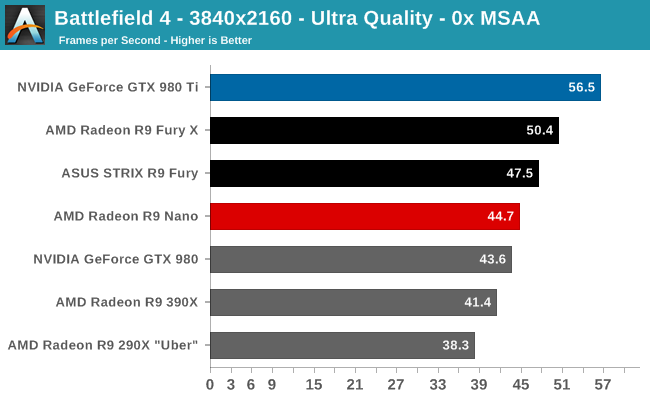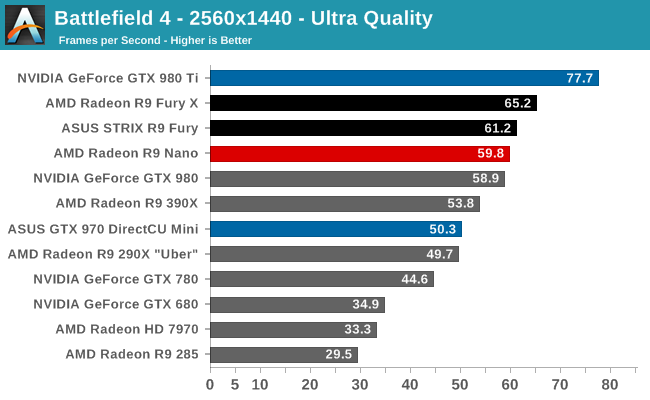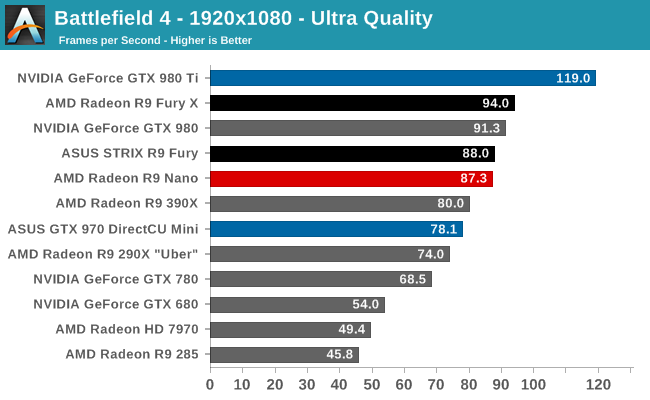The AMD Radeon R9 Nano Review: The Power of Size
by Ryan Smith on September 10, 2015 8:00 AM ESTBattlefield 4
Kicking off our benchmark suite is Battlefield 4, DICE’s 2013 multiplayer military shooter. After a rocky start, Battlefield 4 has since become a challenging game in its own right and a showcase title for low-level graphics APIs. As these benchmarks are from single player mode, based on our experiences our rule of thumb here is that multiplayer framerates will dip to half our single player framerates, which means a card needs to be able to average at least 60fps if it’s to be able to hold up in multiplayer.




Like the other Fiji cards, AMD is promoting the R9 Nano in part on its 4K capabilities. And while we disagree that this card is suitable for 4K gaming based on its sub-Fury performance, we’re including 4K results anyhow to serve as a point of comparison.
In any case Battlefield 4 is often a good indicator of general card performance, and for the R9 Nano this is no exception. What we find is that the R9 Nano trails the other Fury cards in all cases. However to our initial surprise, the R9 Nano sticks rather close to the R9 Fury. The petite powerhouse trails the R9 Fury by only 1-6%, which for the record is a smaller gap than we were expecting.
While the R9 Nano packs a full Fiji GPU, AMD has to pull back on clockspeeds to hit their power targets; in the case of Battlefield 4 this is an average clockspeed of just 879MHz at 2560x1440. Given this we had been expecting the R9 Nano to deliver around 85-90% of the performance of the R9 Fury (and about 80% of the R9 Fury X), based on the assumption that average clockspeeds would be closer to 800MHz. So the fact that the R9 Nano starts off as close to the R9 Fury as it does – even if it’s still trailing it – is a pleasant surprise.
Otherwise with performance still clearly occupying a position as a “3rd tier” Fiji card, I’m not sure if anything about these results should be surprising. On a price/performance basis AMD is not intending to be competitive with other $650 cards, so the R9 Fury X and GTX 980 Ti are of course on the top of the heap. What you get instead is a card that delivers around 90% of R9 Fury X’s performance in BF4 with much less power consumption.
Moving on, compared to the lower power and smaller cards, the R9 Nano is as expected a clean sweep. Demonstrating the virtues of a wide and lower clocked processor’s ability to deliver strong performance without requiring extreme power, everything from the R9 285 to the GTX 980 trails the R9 Nano here. Compared to the GTX 970 Mini in particular, the R9 Nano is 12-26% faster depending on the resolution.
The one potential problem here for the R9 Nano is the GTX 980. Though not a Mini-ITX card, the GTX 980’s power consumption is going to be fairly close to the R9 Nano’s, definitely more so than GTX 970’s. From a power efficiency standpoint it’s the GTX 980 that poses the greatest challenge to the R9 Nano, and while it’s ahead of the GTX 980 in this case at 2560x1440 and higher, it’s a sign that AMD should be worried about what could happen if an NVIDIA partner produced a Mini-ITX GTX 980.










284 Comments
View All Comments
brikbot - Thursday, September 10, 2015 - link
*capacitor ;)tipoo - Thursday, September 10, 2015 - link
Nah, capacitors are the big cylindrical oneshttp://www.thenakedpc.com/dan/Bulging_Capacitors/c...
Resistors are the little ones scattered all over motherboards and other PCBs
https://www.google.ca/search?q=motherboard+resisto...
extide - Thursday, September 10, 2015 - link
No, those are capacitors. They are for decoupling for the GPU power rails, and that's why they have to be right under the GPU as it's as close to the chip as they can get.Furthermore, you can see the designations on the PCB are Cxxx indicating again that they are capacitors.
SMD resistors and capacitors can look identical. You are thinking of electrolytic capacitors (the big round ones) where as these are ceramic capacitors. Also the large black ones with a grey line on the side which are on the opposite side of the PCB relative to the MOSFETS are tantalum capacitors. There are MANY types.
However one rule of thumb that is not always true, but usually is, the tan colored small SMD devices are usually capacitors whereas black ones tend to be resistors, although I stress that this is not always the case. Best way to find out is look at the component designation on the board, if they start with C they are caps, and resistors will start with R.
brikbot - Friday, September 11, 2015 - link
This exactly. And a good example of an exception are film capacitors, which tend to be black.brikbot - Thursday, September 10, 2015 - link
Regarding power consumption for gaming vs FurMark: what impact could AMD's drivers be having? As in, we see cases where the AMD cards are CPU limited and nVidia's cards are not, implying that the AMD drivers drive a higher CPU load that nVidia. This would make sense in my mind with FurMark which loads the GPU down without really applying any loading on the CPU. I guess I'm wondering if the higher power load in gaming, being measured from the wall, is being driven by a higher CPU load as the drivers try to keep the GPU fed whereas in FurMark the drivers do not have the same work, letting the CPU idle, resulting in the lower power numbers.It might make an interesting metric to check in the future, given DX12 changing the impact of drivers.
slapdashbr - Friday, September 11, 2015 - link
Furmark draws substantially more power at a given clock speed than... anything else. It's like intel burn test. It's an unrealistic workload.Daniel Egger - Thursday, September 10, 2015 - link
"GTX 970 is also cheaper and designed to draw less power"Not true, for some stupid reason most mini GTX 970 draw more power and require 2 PCIe connectors.
extide - Thursday, September 10, 2015 - link
Requiring 2 connectors doesnt mean it draws more power, and they are probably 2x6pin which is rated for the same as 1x8pinDaniel Egger - Friday, September 11, 2015 - link
True, there's still the problem that a few mini PSUs only have 1x8 pin PCIe connector and the cards will not start if only one is connected. I'd rather not fool arounds with Y-adapters or other tricks at this amp-age; that can go south rather quickly...Daniel Egger - Thursday, September 10, 2015 - link
"And while we disagree that this card is suitable for 4K gaming based on its sub-Fury performance, we’re including 4K results anyhow to serve as a point of comparison."WTF is this? "And while we disagree that this car is suitable for racing based on its sub-911 GT3 RS performance, we’re including lap times anyway to serve as a point of comparison."